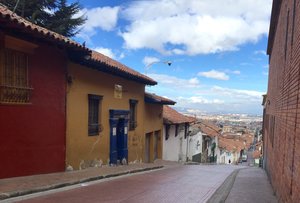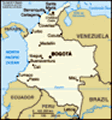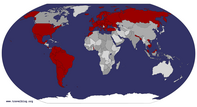Advertisement
Published: December 31st 2015

 Calle 10, La Candelaria
Calle 10, La Candelaria
This is the view down Calle 10 from the apartment I rented in Bogota.When I told people in Cartagena that I was headed to Bogota for New Year's they all shuddered, telling me that it was too cold in Bogota. I wasn't too worried since I knew they were comparing it to the 90F weather in Cartagena. Compared to Seattle I was sure it would still be warm. It's so close to the equator, how cold can it get? While it's true that in the sun, during the day, it is nice and warm, the nights are cold. When I arrived the air felt thinner, drier, than on the coast. So, I looked up the elevation: 8,675 feet, although where I'm staying I have such a great view out over the city that I'm sure it must be at least 8,700 up here.
The apartment I rented off Airbnb is fantastic, just the right mix of historical colonial and modern. The building is from the 1700s but the lighting is all LED. The courtyard has frescoes of the Virgin Mary, but also wifi. It was exactly what I was hoping for!
I'm staying in the historical district, called La Candelaria, a short walk from most of the museums. They might not be

 Museo de Oro
Museo de Oro
Many gold pieces in the Museo de Oro are displayed with other similar pieces. I was most impressed by the displays that placed them over a human figure. Here you can see how the head band, earrings, nose ring and chest plate were worn. Yes, the giant piece coving the lower half of the face is made to hang from the nose.the Smithsonian's, but there are quite a few great museums here. Another thing that jumps out at me about Bogota is the number of bookstores. There must be more bookstores than museums. Every museum has a bookstore, plus there are dozens of independent bookstores. Plus, there are as many street vendors selling books as jewelry. Definitely more book vendors than tourist souvenir vendors in the streets. Another thing they have a lot of is police. Not as many cops as pigeons, but it seems like a close match. Certainly more cops than llamas, although there are quite a few of those being led around so that you can take a picture of your kid sitting on one. At least, that's all I've seen them used for.
I started with the Bogota Museum (free), the museum of Independence ($1USD) and the Museum of Gold ($1USD). All were excellent, although if you have time for only one go to the Museum of Gold (Museo de Oro). I was not prepared for how vast and thorough the museum was. I expected something about what Indigenous tribes used gold for and something about how the conquistadores destroyed their culture in the Spanish quest

 Jaguar Nose Ring
Jaguar Nose Ring
The earrings looked very heavy, but the chest plate has an obvious hole to be strung around the neck. The giant facial covering, representing a jaguar and its power, is one of the many nose rings I saw that looked too heavy to be worn.for gold. It was way more than that. The process indigenous people used to mine here wasn't too different from the California gold rush. A lot of gold could be panned from the rivers, although some tribes also excavated underground mines. Some tribes preferred melting and pouring gold into molds, some preferred hammering out the gold. One thing unique to Colombia was their use of tumbaga, an alloy they made with gold and copper. With as little as 5% gold they could heat and cool the tumbaga to bring the gold to the surface, then oxidize the metal with an acidic plant mixture to facilitate polishing off the copper molecules left on the surface, leaving a gold surface all over the object. The videos and images used to explain all this were very well done.
Besides the process for how people worked with the gold, the museum also had an impressive amount of information on the people themselves. If you are interested in native culture then this museum has to be at the top of your list. The historical information about native people was complimented by information about native cultures today. In Colombia in 2015 there are 84 indigenous

 Gold Chest Plate
Gold Chest Plate
Among the many decorative chest plates in the museum, this was one of my favorites. It shows a face wearing a nose ring with some of the stylized characteristics of the jaguar, but the jaguar is smiling. I saw other chest plates with faces on them, but the none that had smiles.groups and 65 distinct languages. Of course, that's less than there was before Europeans invaded, but it seems that now the groups may be getting some government support and protection.
I was absolutely blown away in the first part of the museum to see how many pieces of jewelry and historical objects have been conserved. I had just assumed that everything had been lost in the conquest and native objects had been melted down to make Spanish candlesticks or crowns or whatever the Spanish made with the gold they plundered from the Americas. But no, there were thousands of amazing example of native Colombian craftsmanship. That was just the first floor. I soon found out that all three floors of the museum are completely full of thousands of pieces of jewelry and other objects made by native Colombians hundreds of years ago. For me, the most impressive part of the museum is the exhibit on shamanism and the purpose of the gold objects that weren't just jewelry. The shamanistic part of the exhibit started with an extensive and thorough explanation on how gold was considered to be an offering to the gods, a way to communicate with the other

 Gold Animal Figures
Gold Animal Figures
Of course, when we can't figure out what something was used for we say it had religious uses. These probably actually did. Hundreds of very detailed and intricate gold birds, lizards, bats and frogs are displayed on every floor of the museum.worlds, above and below. Shamans and tribal leaders derived their power from the amount of gold they had at their disposal to offer to the gods, not the amount of gold they had to barter and buy things with. It was not used as money. It was often sacrificed to the gods in sacred lakes
At the end of this exhibit is a round room that opens every few minutes, people who have just experienced the show leave, and you are ushered in by museum docents. As soon as the doors close behind you, the lights go out. In the dark you hear sounds of water, paddles in a lake, not river sounds. Then you hear chanting, in a native Colombian language. Then some faint lights being to illuminate parts of the walls, reflecting off hundreds of gold earrings, nose rings, figures of sacred animals encircling you. The chanting increases in tempo and intensity and you see the floor light up beneath your feet. You are standing on blue glass, below which are hundreds more gold objects and pieces of jewelry. You hear splashes, as sacrifices are thrown into the water, then the lights dim as the chanting softens

 Gold Museum World Timeline
Gold Museum World Timeline
I loved how every museum had some sort of timeline that showed events in Colombia in sync with global events. In 500BC when native Colombians were first working with gold, Tiahuanaco in Bolivia was becoming an established city, Rome was founded, the Nok culture in Nigeria was developed and a few years later the Buddha was born.and the paddles slice through the water again. When all is dark and silent, the doors open and let you out into the museum again.
The other museum that made a big impression on me was the Botero museum. In general I would say I appreciate art, but I am not an expert on anything. I've learned just enough about French impressionists to teach an hour or two to middle school students. So, I wasn't expecting to be wowed by Botero. Most of his famous works were done in the 80s and 90s, and the gigantesque cartoonish aspect of his work didn't interest me much - until I got to the museum. His paintings were huge! Not only did he imagine everything ballooned out of proportion, he painted on canvases that barely fit on the museum walls. Somehow the giant scale of his giant figures was much more appealing that the two square inch reproductions I had seen in books. I loved seeing his earlier works, from the 60s when he clearly already had established his style. What seemed crazy to me was that he was from Medellin, like Pablo Escobar, and that he had done most of his

 On the street across from the Botero Museum
On the street across from the Botero Museum
Translation: To speak of peace in Colombia does not presume the absence of conflicts or the existence of a model that we could copy. We need words to name this reality and images so we can imagine it. This is the purpose of the project "La Paz se toma la palabra."work in the 80s and 90s, like Escobar. That such violence and such artistic creativity could come from the same place at the same time is hard to comprehend.
The Botero museum also houses a private collection of some incredible works of art. I saw paintings by Picasso, Monet, Matisse, Degas, Gauguin and I am sure there are many more important artists displayed there, but I only know the French ones. There was even a portrait Botero had done of Cezanne.
In the hundreds, if not thousands, of masterpieces displayed, in the last room on the top floor, which is modern sculptures, right at the end I saw a sculpture made by Sophia Vari in 1997. It hit me that I hadn't seen any female artists in all of the rooms and all of the art I had just been looking at for hours. I hoped I was wrong and asked one of the guards if that really was the only work done by a woman in the whole museum. He said that was it, only one female artist and only one piece of art. I could hardly believe it and told him so, adding that it was

 Peace Timeline
Peace Timeline
This timeline documented events in Colombian history from 1900 to 2015 which were moves towards peace. Some were laws, some were resolutions of conflicts, some were disarmaments of paramilitary or guerrilla groups. Most are easy to find in history books, but I was fascinated by seeing them so prominently displayed for all visitors to the capital.ridiculous. He agreed but said since it was a private collection the museum wasn't at liberty to balance the collection with other acquisitions.
It reminded me of a postcard I sent my friend Amanda from London. I saw it on her fridge in LA on my way from Seattle to Colombia, so it's fresh in my mind. It's a photo of a white marble sculpture of a nude woman, wearing a gorilla mask. The caption is "Do women have to be naked to get into the Met?" They were referencing the vast quantity of paintings and statues of naked women in the Metropolitan Art Museum of London, in contrast to the scarcity of art made by women. The same applies in Bogota. A significant percentage of the paintings and certainly the sculptures were of naked women, by Botero and others. But only one artist who is a woman?
After Botero, I went next door to another art museum, which houses mostly paintings, with some photos, spanning from the earliest works made in Colombia in the art school established in 1865 (inspired by exchanges with art schools in Paris) to modern art from today. The collection includes works by

 Part of the Peace Display
Part of the Peace Display
Out of the many developments that Colombia has made towards a peaceful society, one was particularly humanitarian. In 1957, Colombia gave the right to vote to women, allowing them full citizenship and the right to participate in politics.Colombians made both in and out of Colombia, as well as works by foreigners made here in Colombia. I found that I wasn't really appreciating the art as much as I was looking for art made by women. I was still so surprised by there being only one work of art made by a woman in the Botero museum that I couldn't get it off my mind. I started scanning the artists names and only looking at the actual painting if it was painted by a woman. Not intentionally, mind you, but in reflex to feeling like half of the artists in the world had been slighted.
I also visited the national museum, which is mostly history but also displays similar things to the Museo de Oro and the Botero museum. If you've already done those two, don't bother with the national museum unless it has a temporary installation you're interested in. I saw Omar Rayo, who made vibrant and powerful geometric paintings and sculptures, very modern and very cool.
Other than the museums, Bogota has a fantastic array of entertainment in the streets. I saw musicians, of course including accordions and tango dancers, comedians, mimes and chalk

 Museum for Independence
Museum for Independence
This museum had many interesting artifacts from the colonial times. This display showed the strict racial caste system used by the Spanish. I was shocked by the names of many of the racial labels. Under each combination of parents is the label of their child. The child of a native Colombian and an African is labeled "chino chambujo." The child of a "chino" and a mulata (daughter of a European and an African) is labeled a "lobo."artists drawing on the streets with crowds watching. The roads through La Candelaria are mostly for pedestrians. All of the three lane Avenue 7 (carreta) was blocked off for pedestrians and bikes. I didn't see a lot of bikes, though. Just hundreds of pedestrians, at all hours of the day. From the fruit vendors on the street I sampled all the fruits that I didn't try while I was in Cartagena and found that the local pitaya is much tastier than the related dragon fruit I had tried in Asia. Just walking through the streets is entertainment enough. I didn't make it to any other parts of Bogota, since I had more than I could do within walking distance.
As a woman traveling alone, I have to say that in both Cartagena and Bogota I have received less harassment than almost anywhere, except perhaps Cambodia. I was only whistled at once, and that was by a group of construction workers. I've gotten worse from construction workers in the US. Although I know that violence continues to be a reality for many people living in Colombia, especially in rural areas, I felt completely safe everywhere I went on this trip.

 Current Events
Current Events
The museum of Independence also documented more recent history. I had never heard of the M-19 movement and was shocked to watch news footage from 1985 showing tanks rolling up the stairs to the national Palace of Justice. The museum did a very good job of displaying news from 1985 as well as chronicling the ongoing investigations and developments over the past thirty years.All in all, I have had a wonderful time in Colombia and hope to return one day.
This blog is also available on www.heatherjasper.com
Advertisement
Tot: 0.686s; Tpl: 0.022s; cc: 29; qc: 120; dbt: 0.2101s; 1; m:domysql w:travelblog (10.17.0.13); sld: 1;
; mem: 1.5mb





















